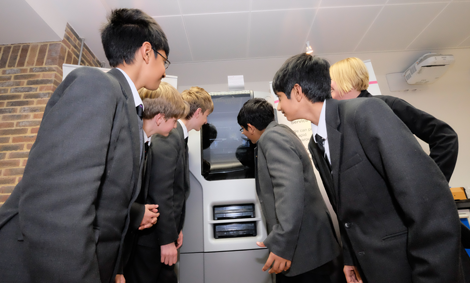
3D printing is being adopted into education faster than most would think
With design and engineering at the highest level adjusting to encompass digital manufacturing, the challenge now remains to prepare an entire generation for 3D printing in their working lives.
DEVELOP3D spoke to Jane Gibbons, a technical sales engineer for Laser Lines, who has the view that the future of 3D printing is in the classroom – which is adopting the necessary skills faster than you’d probably expect.
“Once confined to the worlds of industry and academia, 3D printing is finding itself increasingly at home in a rather different environment: the school classroom,” says Gibbons.

Laser Lines’ Jane Gibbons introduces the pupils of Merchant Taylors’ School, Middlesex, to an industrial 3D printer
“More and more secondary schools in the UK are recognising the importance of rapid prototyping technology and the major role it’s playing in the manufacturing sector in particular.”
Of course, this is of great benefit to her employers Laser Lines, a well established UK 3D printing technologies supplier, but being on the front line gives Gibbons a unique perspective on what is actually happening.
This is definitely the case at Merchant Taylors’ School in Middlesex where Laser Lines has installed a whole suite of Makerbot 3D printers alongside an Stratasys Objet30 Prime – the cheaper machines enabling the pupils to experience 3D printing on a regular basis, while the multi-material Objet30 gives them a glimpse of what the technology can do at the higher end.
As Gibbons points out, the school is fortunate to have two very tech-savvy members of staff – Mike Stephenson and Haydn Hutchings. Both are responsible for spearheading the school’s annual Design and Technology Week, and both are passionate about the role 3D printing has to play in schools.
“It’s great to see just how interested the next generation is in our industry and the technology we work with on a daily basis – and therefore often take for granted,” she explains.
However, this positivity is countered where barriers remain in place, such as access, funding, teacher awareness and confidence.
Merchant Taylor’s School is a great example of all the positives coming together: inspiring teachers helping drive the technology in schools, the availability of more robust and reliable ‘plug-and-play’ machines, and the industry as a whole, from design through to manufacture, supporting ideas like a school’s Technology Week.
“The younger a person is, the easier it usually is to introduce new ideas and concepts,” adds Gibbons. “It’s vital that rapid prototyping technology becomes the norm for schools if the technology is to continue to develop.
“The school pupils of today are the business leaders of tomorrow and it will be down to them to ensure the ongoing success of the 3D printing revolution.”






